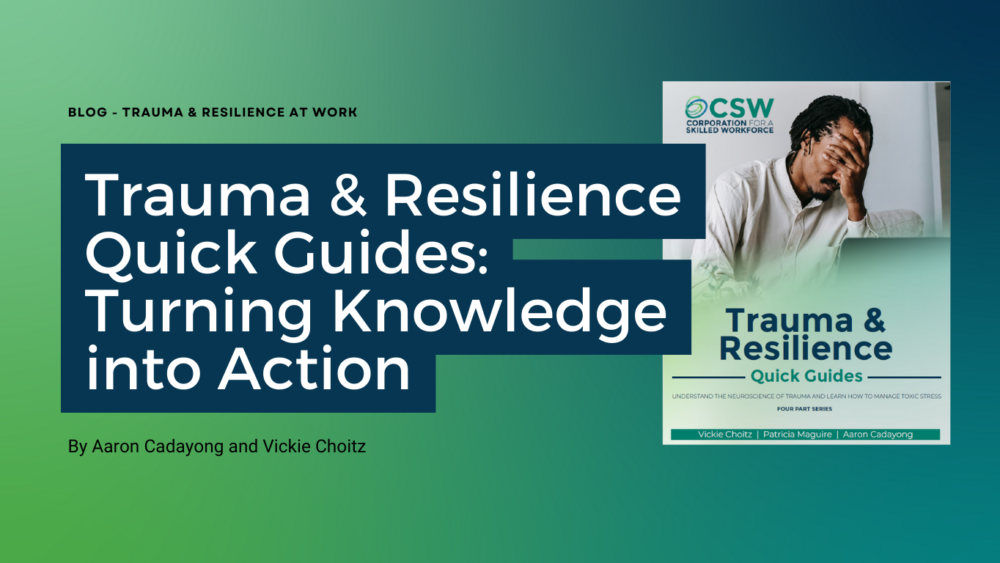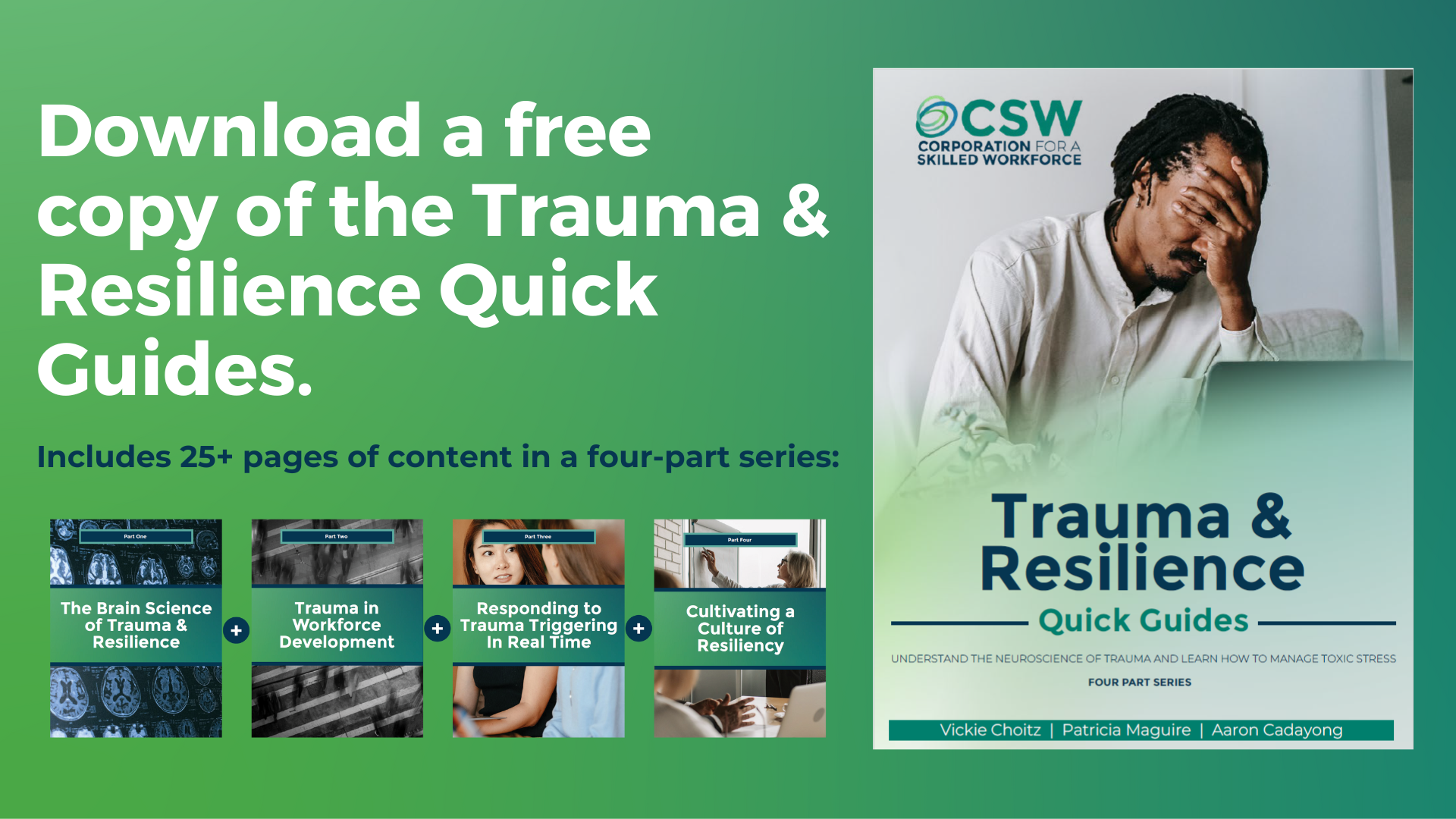Interest in trauma and resilience in workforce development has grown in recent years, contributing to an increase in workshops, literature, and online resources. Despite growing awareness and availability of these resources, translating knowledge into action remains a considerable challenge. This is due in part to the deeply ingrained stigma surrounding mental health issues, as well as systemic barriers within healthcare, workforce development, and social service systems. Implementing trauma-informed practices requires a fundamental shift in mindset and approach, which can be daunting for individuals and organizations accustomed to more traditional or transactional service models.
Here at Corporation for a Skilled Workforce (CSW), we have disseminated insights on this topic through the Trauma & Resilience at Work Quick Guides, offering essential knowledge and practical strategies for fostering trauma-informed practices and resilience in the workplace. The Trauma & Resilience Quick Guides are a free resource which includes four parts, covering:
- The Brain Science of Trauma & Resilience
- Trauma in Workforce Development
- Responding to Trauma Triggering in Real Time
- Cultivating a Culture of Resiliency
Don’t have a copy of the Trauma & Resilience Quick Guides yet? Download your free copy here.
We surveyed organizations who are implementing the Trauma & Resilience Quick Guides to find out how they’re turning knowledge into action, and five recommendations emerged:
1. Use the quick guides to better serve your clients:
Individuals and organizations from a variety of fields have found wide-ranging approaches to turn the information in the Trauma and Resilience Quick Guides into action. Some workforce development professionals indicated that they keep a printed copy of the Quick Guides at their desk to refer to if clients demonstrate trauma symptoms.
TRY THIS: pages 16-18 outline a quick step-by-step process for responding to a triggered client with a trauma-informed approach. Referencing the guides often helps staff integrate trauma-informed knowledge and practices into their everyday coaching with participants.
“I have used the guide tools in order to enhance service and care to my participants facing the healing of trauma.”
2. Use the quick guides for new staff onboarding & training:
Organizations have effectively utilized the Quick Guides for staff professional development, incorporating them into new staff onboarding and ongoing staff supervision. Some organizations provide printed versions of the guides to all new staff during the onboarding process.
TRY THIS: Pages 6-9 of the Quick Guides provides an understanding of the difference between stress and trauma, the different types of trauma, and how the brain reacts to stress and trauma. This may help new staff better understand their own potential response to the stress of a job transition.
3. Implement the quick guides for professional development:
The Quick Guides serve as a great reference document during one-on-one reflective check-ins with staff. By reviewing resilience-building practices in the quick guides, staff members are better equipped with knowledge, such as how trauma might show up in a workforce development program and how to better serve clients using trauma-informed approaches. Additionally, it encourages staff to reflect on their own mental health and self-care practices, ensuring that all staff benefit from trauma-informed reflection and support
TRY THIS: discuss the Six Key Principles for a Trauma-Informed Approach on pages 21-26 with staff, focusing on two simple but powerful questions around each of the six principles: (1) What are examples of this principle in action in our team or organization now? And (2) How can we deepen the application of this principle in our team or organization? Additional topics in the guide that work well for team meeting discussions include recognizing symptoms of trauma in the workplace (pages 10-12) and how to use the LAPIS model to respond in a healthy and trauma-informed way (pages 16-18).
4. Use the quick guides for passive training:
Staff have used the guides in creative ways through passive training opportunities. Some have displayed the Resilience Rainbow infographic from the guides in the office to provide clients and staff with visible reminders of the strategies for bolstering resilience. Others post the infographic on the brain science of trauma to help workforce development participants and staff understand that trauma responses are normal responses to abnormal events.
TRY THIS: print one of the many infographics in the Quick Guides and post in a visible location in your office. Consider using the Resilience Rainbow on page 9, the Types of Stress graphic on page 6, or the Brain’s Reaction to Stress and Trauma graphic on page 8.
“We have shared the Trauma and Resilience Quick Guides to all of our team, and we talked about it during our team meeting to keep a copy on our desk to always look back on because we do have clients daily and some days are good, other days are heavy. So having this in hand is perfect.”
5. Share the quick guides with your community:
Practitioners have shared the guides with alumni, community members, and partners, using it as an opportunity to help those outside their immediate organizations. Some workforce development staff have even created their own workshops for program participants on trauma and how it might affect them, as well as strategies for regulating how trauma affects them, healing, and self-care.
TRY THIS: Include the Trauma & Resilience Quick Guides as a bonus resource in future meetings with program participants or community partners. Give away a nicely printed and bound copy of the Quick Guides as a door prize at an upcoming meeting with community partners.
“I am exposed to much content in this area in my position and I find yours some of the best out there – simple, yet thorough.”
The true power of the Trauma and Resilience Quick Guides lies in their practical application. Share with us how you are doing this by answering our two-question survey.
Meet the Author
Aaron Cadayong
Aaron Cadayong is an Intern on the Trauma and Resilience at Work Team, where he assists in advancing the team’s mission. With an initial focus on creating the Trauma and Resilience at Work Guide, Aaron also contributes significantly to the team’s communication efforts, crafting newsletters and blogs that disseminate valuable insights to a broader audience. Continue Reading >>
Meet the Author
Vickie Choitz
Vickie Choitz is the Director of Trauma and Resilience at Work team, advancing workplaces and workforces that are culturally responsive, trauma-informed, healing-centered, resilience-building, and supportive of mental well-being. Continue Reading >>






Comments are closed.